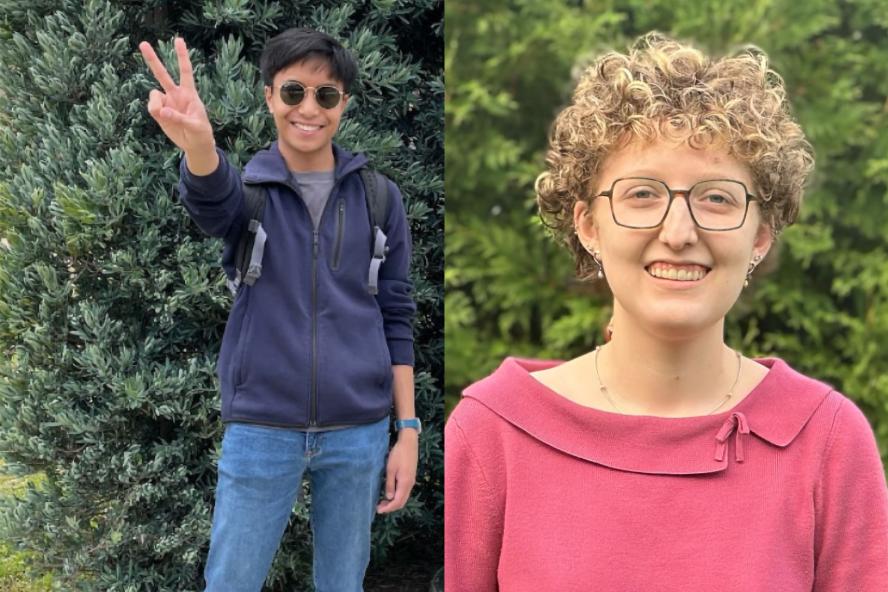Instructor Spotlight: Cuilandra Nero and Raymond Rosales

Tell us about yourself and what inspired you to teach this course
Culiandra Nero: Children's cartoons were a big part of my childhood and something I continue to watch even now. On a friend’s recommendation, I became a CSHD major at Tufts and found out there was a children’s media track. I am considering what I want to do after college, so I saw teaching this course as a way to see if teaching might be something I am interested in, to further explore my own academic interest in children’s media, and to share something I love and am passionate about with other people.
Raymond Rosales: I’ve been a part of cartoon fandoms for the vast majority of my life, and I fell in love with animation as a medium at a young age. My parents had saint-like patience, listening to eight-year-old me quote every moment of SpongeBob I could. Needless to say, I would be a different man were it not for that yellow frycook. Being able to teach a class as an undergraduate is an opportunity that only Tufts seems to offer, so I decided to make the most of my college experience while I was still enrolled. I never imagined I would help incoming students adapt to college or teach them about the shows I watched growing up, but I could not be any happier doing so.
What were your favorite cartoons when you were a child? Do you have a favorite cartoon now?
CN: I think my favorite cartoon as a child was definitely SpongeBob. It is the one I have the clearest memories of watching over and over. My favorite now would probably be The Amazing World of Gumball; I really enjoy the humor in the series. However, I have also recently been rewatching Gravity Falls for the first time since I was a child, and I am definitely developing a softer spot for it.
RR: There were so many cartoons I loved as a child! I was enamored with SpongeBob, Gravity Falls, and even My Little Pony. As for right now, that’s tough. There’s so many good ones nowadays. But I’ll go with Gravity Falls since it's had a recent resurgence in popularity. Also the ciphers and codes in it may have primed me for computer science.
Explain some of the misconceptions around children’s cartoons and how you hope to address these in your course
CN & RR: In the US, the dominant viewpoint is still that anything animated is strictly for children and when there is animation aimed towards adults, it’s commonly thought of as raunchy comedies with “ugly” art styles (Rick and Morty, Big Mouth, South Park, etc.). We hope to address these two misconceptions throughout our course by highlighting that cartoons, even when created primarily for children, are still produced and crafted to appeal to adults as well. As for “adult cartoons,” we will spend a class looking at shows like Blue Eye Samurai and Scavengers Reign which deal with heavy themes and subject matters which break the crude stereotype of adult animated shows.
How has the content of cartoons evolved over the years? How have those evolutions impacted the public’s general understanding and appreciation of cartoons?
CN & RR: When children’s cartoons on television started to gain popularity in the ’60s and ’70s, their main goal was to sell toys. These shows had small animation budgets and included little (if any) educational material in their broadcasts. In the years since then, there has been a big shift in regulations. More children's cartoons have put a much larger emphasis on educating children while also entertaining them, like Dora and Molly of Denali. And while cartoons at one point were viewed as visual/mental junk food for children, the perception has changed a lot with the popularity of shows like Arthur. Cartoons are now generally viewed as at least semi-educational.
What do you hope that students will take away from your course?
CN & RR: We hope students will more deeply understand the importance of children's cartoons and the impact they can have. In many ways media has become the “other parents” in children's lives. They learn from media both good and bad. The extent to which this has affected children’s upbringings, including our own, cannot be understated. So, we hope to give the students a new appreciation and understanding of this form of media going forward.
What is something coming up in your course that you are excited about?
CN & RR: In a few weeks, we are going to teach our students how to write an episode for a children’s cartoon. We’re really excited to do this activity because we think the students will enjoy getting to tap into their own creativity for the project, and we are also excited to see how they use some of the principles and concepts they have learned this semester to craft their own episode.
Culiandra Nero (she/her) is a senior from Oxford Hills, Maine, who is double majoring in Child Studies & Human Development (CSHD) and Film & Media Studies (FMS). On campus, she is the president of the Child Development Association and the president of the Anime Club.
Raymond Rosales (he/him) is a senior from Montvale, New Jersey, who is double majoring in Mathematics and Computer Science. He is president of the GNU/Linux User Group and an active member of the Anime Club.